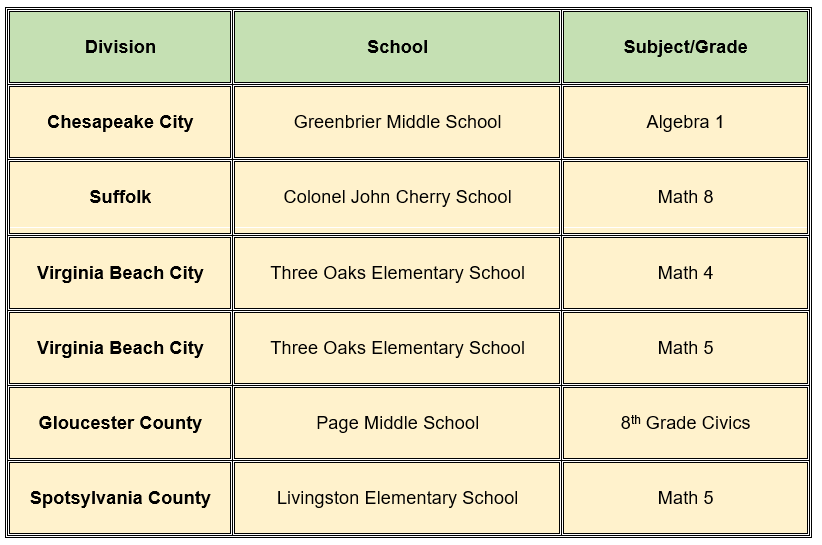By Shelley Littleton, M.Ed., and Donni Perry, M.Ed.
Have you ever wondered what inclusion looks like in other schools? Many schools in Superintendent’s Regions 2 and 3 have been recognized by the Virginia Department of Education (VDOE) through the Inclusive Practice Partnership Project for including students with disabilities in general education classes.
When asked to use one word to describe their overall experiences with inclusion, the educators responded with: “student-centered,” “hopeful,” “amazing,” “progress,” “challenging,” and “wow!”. They also agreed that inclusion benefits teachers, parents, staff members, and students with and without disabilities.
Why do so many educators believe in inclusion and how do they know it works? Find out by reading their answers to three critical questions:
– Why is inclusion important?
– How do you plan for successful inclusion?
– How do you know inclusion is working?
| Why Is Inclusion Important? |
| “Inclusion helps promote equity, acceptance, and unity within our classrooms and schools. These are critical social understandings as functional adults. We all have different abilities and disabilities, and we need to be able to understand each other and work together.”
–Amelie Smucker, special education teacher |
| “We all exist in the same world together. To restrict a child’s experiences based on differences in emotional, social, or intellectual status limits a child’s full experiences in life. A rich life, full of experiences is something we are all privy to.”
–Jessica Gilligan, fifth-grade general education teacher |
| “There is so much learning that takes place from one student to another student in general education classes. If students with disabilities aren’t hearing that information, they are missing out. Research supports the idea that questions students with disabilities come up with will benefit the whole class.”
–Candice Welch, assistant principal |
| “I have experienced the positive benefits my students have when given maximum opportunities to learn with, from, and among their peers.”
–Murray Newman, teacher of the visually impaired |
| “All students can learn, and they deserve to learn in the least restrictive environment.”
–Dr. Ann Colorado, assistant principal |
| How Do You Plan for Successful Inclusion? |
| “We started thinking about our IEPs and writing them a little differently so that collaborative planning time is built into the school day. During this time, we work on creating/modifying assessments and lessons, lesson planning, accommodations, needs, behaviors that have shown up, really anything and everything that needs to be done.”
–Susie McFatridge, special education teacher |
| “We use strategic placement in our master schedule. The special education lead, guidance department, and administrative team are all involved in master scheduling. We make sure that the students with disabilities have the same case manager throughout high school.”
–Candice Welch, assistant principal |
| “I plan weekly to include my plans for small group instruction. On Friday afternoons, I meet with the special education team to talk about concerns and the plans for the upcoming week.”
–Stephanie Carroll, fourth-grade general education teacher |
| “I make an effort to get to know everyone who is involved or might be involved in the child’s education: Parents or guardians, former teachers, current teachers, and each staff member that supports the learning process, from guidance counselors to classroom aides.”
–Murray Newman, teacher of the visually impaired |
| “I plan for inclusion by assuming that every student belongs. Then, I identify their individual barriers and ways to meet their needs. Sometimes this is on a large scale like helping select the best classroom or schedule for a student, and sometimes this is seen in small details like collaborating with other teachers to use common language or strategies when teaching and talking with a student.”
–Amelie Smucker, special education teacher |
| How Do You Know Inclusion Is Working? |
| “I know that inclusion is working because my students are able to perform at desired levels. Students are able to engage in discussions with peers and teachers in a meaningful way. Also, students are able to apply the information learned in other lessons.”
–Jeremy Lichliter, fourth-grade general education teacher |
| “When the assessments show progress and their social skills are improving.”
–Hannah Schrack, first-grade general education teacher |
| “The learning specialists collect data on each student’s performance, and with our Collaborative Planning system, talk about student progress and needs with each inclusion teacher each week.”
–Dr. Ann Colorado, assistant principal |
| “We look at data, grades, and behavioral performance over a period of time.”
–Candice Welch, assistant principal |
| “When all students truly feel like they belong in a class – not just in the room, but part of the class family. They talk to their friends and family members outside of school about their class, and they are referring not to a special education class, but to a general education classroom.”
–Susie McFatridge, special education teacher |
Check out these photos from schools involved in the Inclusive Practice Partnership Project.
High School Geometry Classroom
Arrangement for Station Teaching
In Figure 1, the desks are arranged to support station teaching, a co-teaching approach. In the center of each cluster of desks, there are white boards, dry-erase markers, and directions for each station. In addition, anchor charts decorate the walls to serve as a visual support for all students.
Figure 1. Station teaching.

Third-Grade Classroom
Arrangement for Small-Group Instruction and Flexible Seating
In Figure 2, notice that the tables and chairs are different sizes. Students may choose where they sit each day. Needed materials are in plastic “book boxes” that can be transported to and from work spaces. Figure 3 shows flexible seating options such as seats that allow students to wiggle and bounce as they are working, which can reduce the need for sensory breaks outside of the classroom.
Figure 2. Flexible seating selection.

Figure 3. Flexible seating options.

Fifth-Grade Classroom
Kidney-Shaped Table for Flexible Groupings
The stools shown in Figure 4 can easily be pushed under the kidney table to save space when they are not being used. The co-teachers work with students on targeted skills within the general education classroom.
Figure 4. Flexible groupings.

Second-Grade Classroom
Station Teaching and Flexible Seating
Co-teachers can easily deliver instruction through a station teaching approach within the classroom arrangement shown in Figure 5. The general and special education teachers can each lead a smaller group, while other students work independently. Figure 6 shows how student reading boxes, sight word rings, and flexible seats are stored. An established routine helps students know what to do when they are not directly working with a teacher.
Figure 5. Co-taught classrooms.
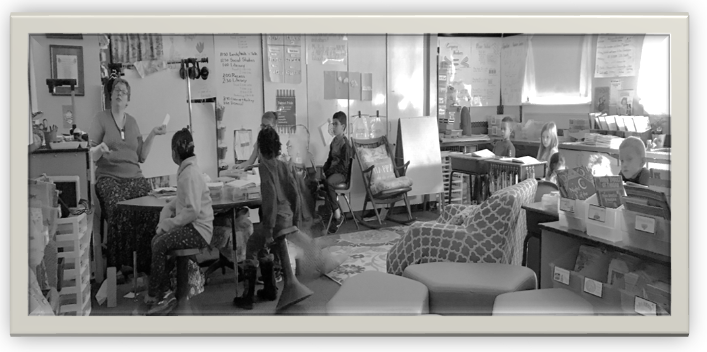
Figure 6. Storage.
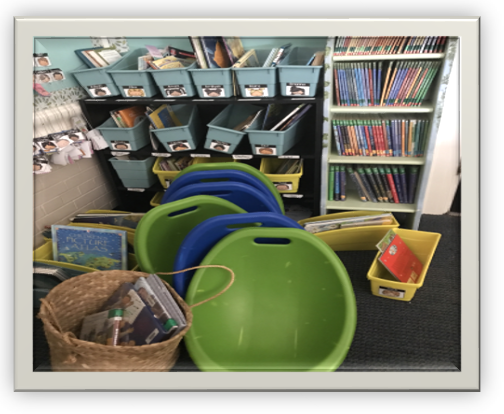
Third-Grade Classroom
Station Teaching and Anchor Charts
Figure 7 shows a classroom structure that supports station teaching. Students can rotate through independent stations at the clusters of desks to review previously taught concepts. The general education teacher and special education teacher can each provide direct instruction and guided practice through station rotations at the kidney tables. Notice the anchor charts on the window shades, which serve as a visual support for students to reference while working in stations.
Figure 7. Station teaching and visual supports.

Fourth-Grade Classroom
Small-Group Instruction for Math and Reading
The classroom arrangement in figure 8 allows for flexible groupings. During math and reading time, students can work on independent assignments and group projects at their desks, while the general education teacher delivers new instruction to rotating groups at the kidney table. The special education teacher can deliver specially designed instruction at various places within the classroom as small group structures are already in place.
Figure 8. Alternative teaching.
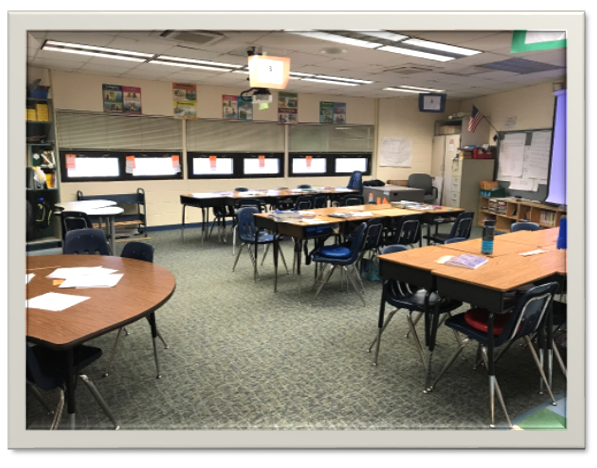
Fifth-Grade Classroom
Parallel Teaching Structure
Figure 9 shows a parallel teaching arrangement that includes kidney tables and teaching space in the front and back of the classroom. The general education teacher and special education teacher can easily split the class into heterogeneous groups to deliver the same lesson within one classroom to lower the student-to-teacher ratio. There are two sets of materials such as anchor charts, calculators, and easels to allow both teachers to simultaneously deliver lessons.
Figure 9. Parallel teaching.
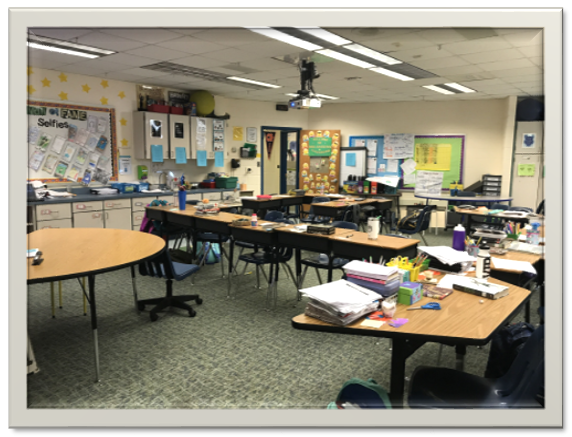
Want More Information?
Visit the VDOE Inclusive Practices website to view videos, blogs, articles, and other resources from teacher leaders in inclusion and co-teaching.
Also, access the following related articles and podcasts from the Training and Technical Assistance Center (T/TAC) at William & Mary.
Articles Related to Inclusion
Creating an Environment of Inclusion
Inclusion: What, Why, and How?
Lesson Design for an Inclusive Classroom
Power Tools: IEP Planning and Specially Designed Instruction
Balanced Rosters in Co-Taught Classes: A Critical Factor in Successful Co-Teaching
Podcasts Related to Inclusion
Sustaining a Quality Co-Teaching Program–Recommendations by Marilyn Friend
Data Collection and Analysis Podcast with Janelle Spitz
Additional Inclusion Resources
Do you want to see inclusion in action? Apply for a stipend through T/TAC William & Mary to support your visit to an Excellence in Co-Teaching Demonstration Site near you.
Co-Teaching Excellence Demonstration Sites
in Regions 2 & 3 (2018-2019)
